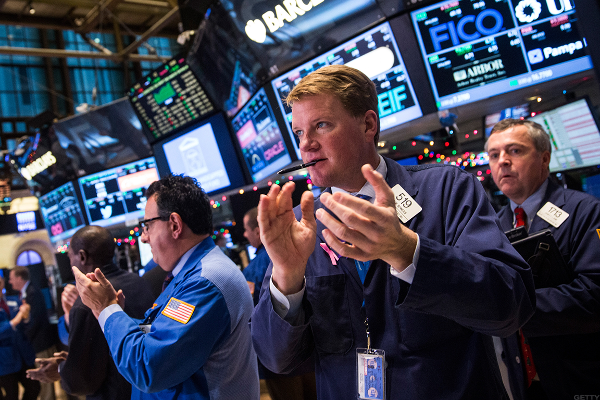
- Global stocks weaken amid reports that President Donald Trump will imposed 10% tariffs of $200 billion worth of China-made goods as early as today.
- China vows to retaliate, with reports it plans to target U.S. supply chain with export limits as U.S. tariff level looks set to surpass total China export total.
- China’s Shaghai Composite slides 1.1% to close at the lowest level in nearly four years.
- European stocks open weaker, with autos leading the decline, as trade war talk blunts risk sentiment and Brexit headlines keep pound and FTSE volatile.
- U.S. stock futures look set to clip 40 points from the Dow Jones Industrial Average while 10-year U.S. Treasury yields inch towards 3%.
Global stocks weakened Monday, pulling U.S. equity futures into the red, as investors pulled cash from risk markets around the world amid reports that President Donald Trump is ready to impose tariffs on $200 billion worth of China-made goods as early as today while official in Beijing have vowed to retaliate to protect the nation’s interests.
The rapid escalation of the ongoing trade war between the world’s two biggest economies, which has been simmering for months, snapped a three-day winning streak for stocks in Asia, which fell notably amid thin market liquidity owing to a national holiday in Japan which kept markets closed throughout the session.
The Wall Street Journal’s weekend report of a Trump Administration plan to slap tariffs of 10% on $200 billion worth of product was enough to have kicked off a weaker Asia session, with caution increasing amid both China’s reply — in the form of an editorial in the state-run Global Times Newspaper — which said the country was “looking forward to a more beautiful counter-attack and will keep increasing the pain felt by the U.S.”.
That view dovetailed with the Journal’s reporting that suggested China may selectively target components essential to the U.S. supply chain as part of its retaliation, a move that could disrupt end-production schedules, especially in the tech sector, if the White House goes ahead with its threat. China has also reportedly said it will skip planned trade talks with Treasury Secretary Steve Mnuchin if the Trump tariffs are imposed.
The MSCI Asia ex-Japan index, the region’s broadest measure of share prices, was marked 1.1% lower heading into the final hours of trading, led by loses in mainland China, were the Shanghai Composite fell 1.1% to close at 2,651.79 points, the lowest since November 2014. Hong Kong’s Hang Seng index was also sharply lower, falling 1.85% as the island recovered from the impact of super typhoon Mangkhut, the most severe in the city’s history that brought 120 mile per hour winds and severe flooding in certain areas.
Early indications from U.S. equity futures suggest follow-on weakness on Wall Street, as well, with contracts tied to the Dow Jones Industrial Average marked for a 5 point pullback while those linked to the S&P 500 suggest a 0.5 point dip for the broader benchmark.
China’s implied threat to disrupt the tech-sector supply chain, which many of the biggest U.S. sector companies heavily rely upon, is likely to add to recent concerns for share price performance. The S&P 500 Information Technology Index is down 1.15% so far this month, while the Philadelphia SE Semiconductor index, a benchmark for the chip sector, is down 1.7%.
European stocks opened in the red, as well, with the Stoxx 600 index falling 0.12% to 378.38 points in the opening hour of trading, led to the downside by the auto sector, which is hyper-sensitive to trade war headlines.
H&M (HNNMY) , the world’s second-largest clothing retailer, was a notable early market mover, with shares rising 9.68% in the opening minutes of trading after the Swedish group posted stronger-than-expected third quarter sales of $6.2 billion even as it cautioned that a new logistics system would lift its cost base in major markets
Britain’s FTSE 100 was marked 0.15% lower in the opening minutes of trading, with the pound rising to 1.3082 against the dollar, with both market increasingly volatile amid the headline risk of the country’s Brexit negotiations, which could be heading into a critical six-week period as the deadline for a trade agreement with the EU looms head of Britain’s planned withdraw from the block in March 2019.
Interestingly, despite the weakness in global stocks, and a modest pullback in the U.S. dollar index, U.S. Treasury bond yields resumed their climb in overnight trading, lifting 10-year notes to 2.992%. Benchmark 2-year notes were seen at 2.782%, as well, in early European trading, suggesting investors are having a hard time taking down the excess supply from the Treasury linked to the rising U.S. budget deficit.
Global oil prices were little-changed from their Friday close in early European trading as markets reacted to both the prospect of weaker demand from China in the wake of an escalated trade spat with the United States and the impact of U.S.-imposed sanctions on the sale of Iranian crude in November.
Brent crude contracts for November delivery, the global benchmark, were seen 16 cents higher from their Friday close in New York and changing hands at $78.25 per barrel as the market opened in London while WTI contracts for the same month were marked 20 cents higher at $68.97 per barrel.

